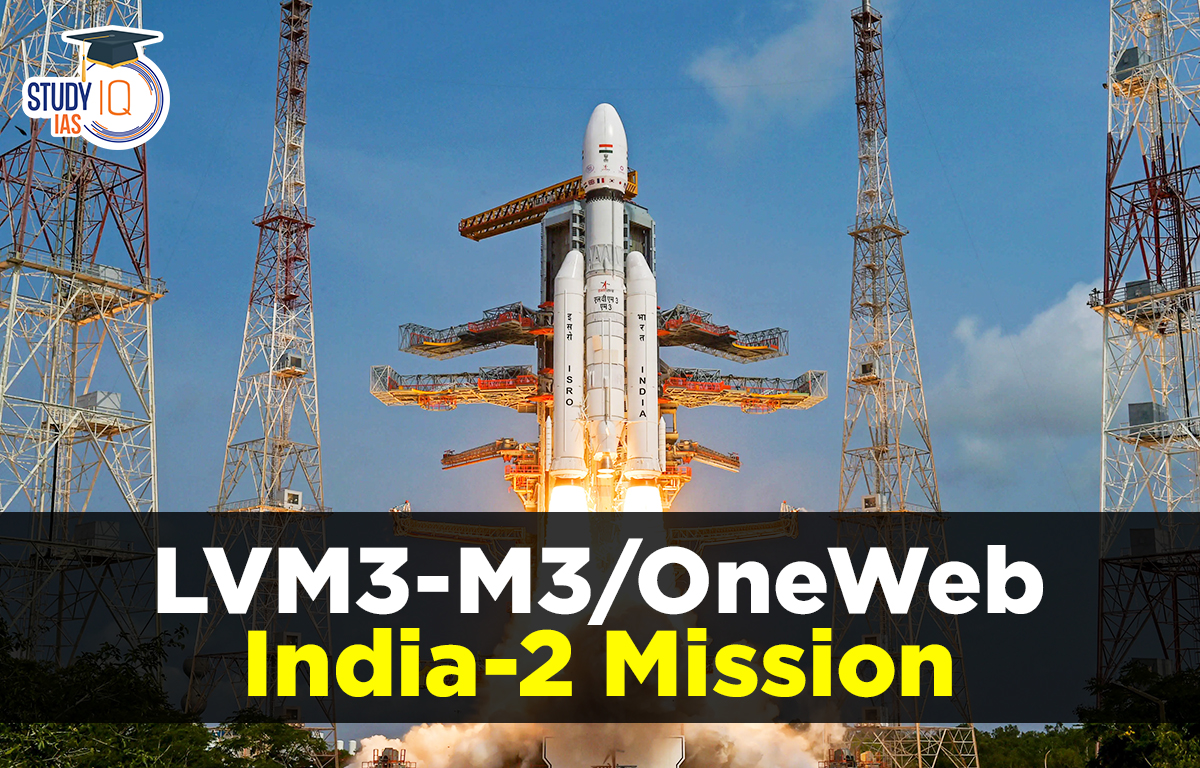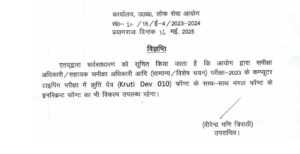Table of Contents
Context: In its second commercial launch, Indian Space Research Organisation (ISRO)’s LVM-3 (Launch Vehicle Mark 3) successfully placed 36 OneWeb satellites in low earth orbit (LEO).
What is the LVM3-M3/OneWeb India-2 Mission?
- About: It is a joint mission between the ISRO and OneWeb, where ISRO’s LMV-3 rocket was used to launch 36 OneWeb internet satellites into orbit for the OneWeb satellite constellation.
- This is OneWeb’s 18th launch, its third this year, bringing the total of OneWeb’s constellation to 618 satellites.
- Background: ISRO’s commercial arm New Space India Limited (NSIL) had signed a contract with OneWeb to launch 72 satellites in two phases.
- The first set of 36 satellites was launched in LVM3-M2/OneWeb India-1 mission on October 23, 2022.
- Significance: This is the second OneWeb fleet that ISRO has launched. This initiated India’s journey into the commercial heavy lift-off space.
About the OneWeb Constellation
- OneWeb is a satellite constellation being built by OneWeb, which aims to provide broadband satellite Internet services.
- OneWeb (legally Network Access Associates Ltd) is a UK based communications company.
- Features of the constellation:
- The constellation uses low earth orbit (LEO) satellites to provide broadband internet access instead of the traditional method of using satellites placed in geostationary orbits (GEO).
- Satellites are arranged in 12 rings (Orbital planes) with 49 satellites in each plane.
- The orbital planes are inclined to be near polar (87.9 Deg.)
- The orbital planes are 1200 km above the Earth. Each satellite completes a full trip around the earth every 109 minutes.
- Significance:
- Internet advancement: OneWeb’s low Earth orbit (LEO) satellites provide greater coverage, speed, and reliability compared to traditional systems.
- Bridging the Digital Divide: OneWeb aims to provide internet access to remote and under-served areas around the world, bridging the digital divide.
- Disaster Relief and Emergency Communications: OneWeb’s network can be used for disaster relief and emergency communications, providing a reliable means of communication when traditional infrastructure is damaged or unavailable.

What is LMV-3?
- The Launch Vehicle Mark-3 (LVM3), previously referred as the Geosynchronous Satellite Launch Vehicle Mark III (GSLV Mk3), is a medium-lift launch vehicle developed by the ISRO.
- The LVM3 will go everywhere —GEO, Medium Earth orbit (MEO), LEO, and missions to the moon, sun.
- Stages: It is a three-stage launch vehicle consisting of two solid propellant S200 strap-ons on its sides and core stage comprising L110 liquid stage and C25 cryogenic stage.
- Capacity: The rocket is capable of launching 4,000-kilogram class of satellites into GTO (Geosynchronous Transfer Orbit) and 8,000 kgs of payloads into LEO.
- Other important launch vehicles of ISRO:
- Satellite Launch Vehicle (SLV): The first rocket developed by ISRO was simply called SLV, or Satellite Launch Vehicle.
- Augmented Satellite Launch Vehicle (ASLV): SLV and ASLV both could carry small satellites, weighing up to 150 kg, to lower earth orbits. ASLV operated till the early 1990s.
- Polar Satellite Launch Vehicle (PSLV): PSLV’s first launch was in 1994, and it has been ISRO’s main rocket ever since.
- It is the first Indian launch vehicle to be equipped with liquid stages.
- PSLV is the most reliable rocket used by ISRO to date, with 52 of its 54 flights being successful.
- It successfully launched two spacecraft – Chandrayaan-1 in 2008 and Mars Orbiter Spacecraft in 2013.
- Geosynchronous Satellite Launch Vehicle (GSLV): GSLV is a much more powerful rocket, meant to carry heavier satellites much deeper into space.
- The indigenously developed Cryogenic Upper Stage (CUS), forms the third stage of GSLV Mk II.
- GSLV Mark-III is the most advanced one and was used to launch the Chandrayaan-2 mission to the moon in 2019, which was the first operational flight of the rocket.
- ISRO has renamed the GSLV Mark-III as Launch Vehicle Mark-III (LMV-3).

Related Information: Important reforms to promote private players in space sector
- Indian National Space Promotion and Authorization Centre (IN-SPACe):
- IN-SPACe is an autonomous, single window nodal agency; formed to promote, authorize, monitor and supervise the space activities of Nongovernmental Private Entities (NGPEs) in India.
- Mandate and Functions:
- Sharing of space infrastructure and premises under the control of ISRO.
- Establishment of temporary facilities within premises under ISRO.
- Establishment of new space infrastructure and facilities, by NGPEs.
- The decision of IN-SPACe shall be final and binding on all stakeholders including ISRO. NGPEs will not be required to seek separate permission from ISRO.
- New Space India Limited (NSIL):
- It is country’s first public sector undertaking in the space sector and commercial arm of ISRO aimed at production and marketing of space-based services, also empowered to own the operational launch vehicles and space assets of ISRO.
- It enables better collaboration with start-ups and private sector players without the hassle of government intervention.
- Draft Spacecom Policy 2020: It aims at meeting the growing demands of space-based communication requirements of the nation and advancements in the relevant technologies for self-sustenance in areas of commercial, secured and societal communications.


 UPPSC RO ARO Exam Date 2025 Out: Typing ...
UPPSC RO ARO Exam Date 2025 Out: Typing ...
 Maharashtra Bill to Curb Urban Naxalism,...
Maharashtra Bill to Curb Urban Naxalism,...
 International Maize and Wheat Improvemen...
International Maize and Wheat Improvemen...





















